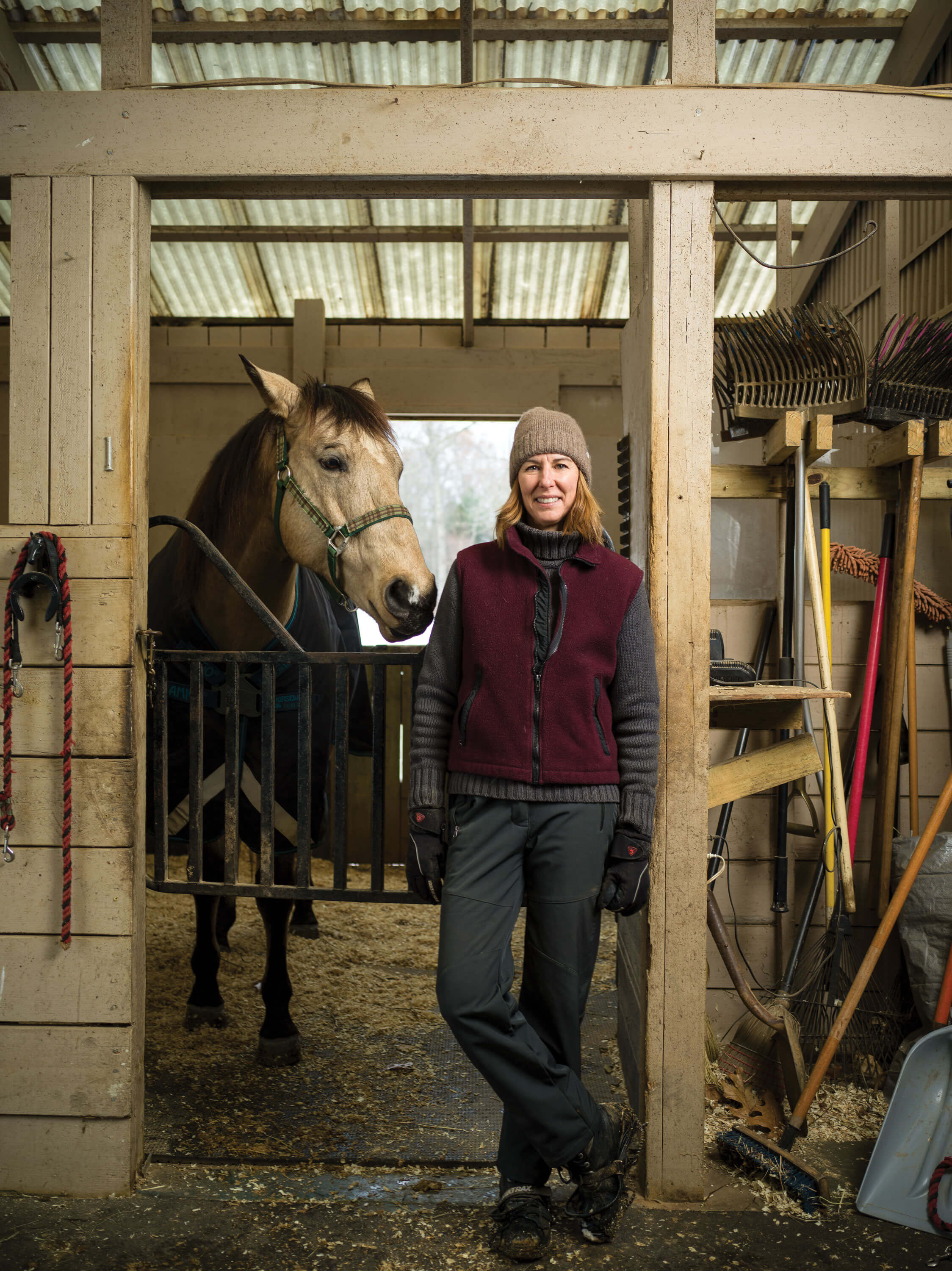
Healing with Horses
René Stone discovered the benefits of equine therapy while recovering from her own personal trauma. Now she’s using horses to help veterans suffering from PTSD.
It had been nearly four decades since Michael served as a combat soldier in Vietnam, but he bore psychological wounds that felt as raw as they did when he first returned home. And they showed no sign of healing. He was perpetually fearful of open spaces and couldn’t recall the last time he’d slept through the night, tormented as he was by terrors that awoke him at odd intervals, compelling him to uncomfortably wedge himself under his bed for some sense of security. But then he visited Serenity Stables, and something fundamental began to change.
Founded in 2015 by Monmouth University alumna René Stone, Serenity Stables, From Combat to Calm, is a nonprofit farm in Atlantic Highlands, New Jersey, that provides what’s known as equine-assisted therapy to U.S. veterans returning from deployment with a broad range of physical, psychological, and emotional disabilities. It’s part of a growing trend across the country aimed at using the unique temperament and intuition of domesticated horses to help veterans work through myriad developmental and physical disabilities, including the severe mental health challenges that stem from post-traumatic stress disorder (PTSD).
“I grew up around military men, and I know that when these men are traumatized, they won’t sit on a couch and talk to someone about how they feel. And here’s the thing about PTSD—when you have PTSD you don’t feel anything,” says Stone, a mortgage loan originator by trade who has more than two decades of experience owning and caring for horses. “There’s a change that happens to you on a biological level when you’re traumatized. You’re frozen. It’s not that you don’t want to cry, it’s that you don’t know where crying is. What the horses do is evoke emotion. They unlock the frozen part of you. And no matter how hard you try to stay frozen, you are going to melt when you’re around them.”
And that’s precisely what happened with Michael. As part of a larger group of Vietnam vets visiting the farm one morning in 2017, Stone asked Michael to walk into the field and spend some time with her stable of six horses. Not to ride them or walk them or groom them—just to spend time with the herd. And as he found himself standing there amongst the animals, their unavoidable evocation of presence and immediacy helped Michael begin healing in ways that were as surprising as they were instantaneous.
“He came back from the field and said to me, ‘I can’t believe this, but that’s the first time in decades that I’ve been out in an open space when I wasn’t thinking about being ambushed,’” recalls Stone. “About four days later I got a call from Michael’s therapist and he told me that Michael woke up in his bed after sleeping through the night for the first time in as long as he could recall. And that was after just one session with the horses! This was very early on in our journey, and that’s when I realized we have a very powerful way to heal these men.”
And Stone knows better than most just how profound a role horses can play in processing and healing the scars of trauma. After all, it was a horse that saved Stone from her own psychological turmoil many years ago.
***
Stone’s love of horses stretches back to her childhood growing up in Keyport, New Jersey, when her boyfriend’s sister brought Stone to visit her stable in Holmdel. Stone’s affection for horses was immediate, not only because of the animals’ aesthetic beauty, but also because of their distinctive and disarming disposition.
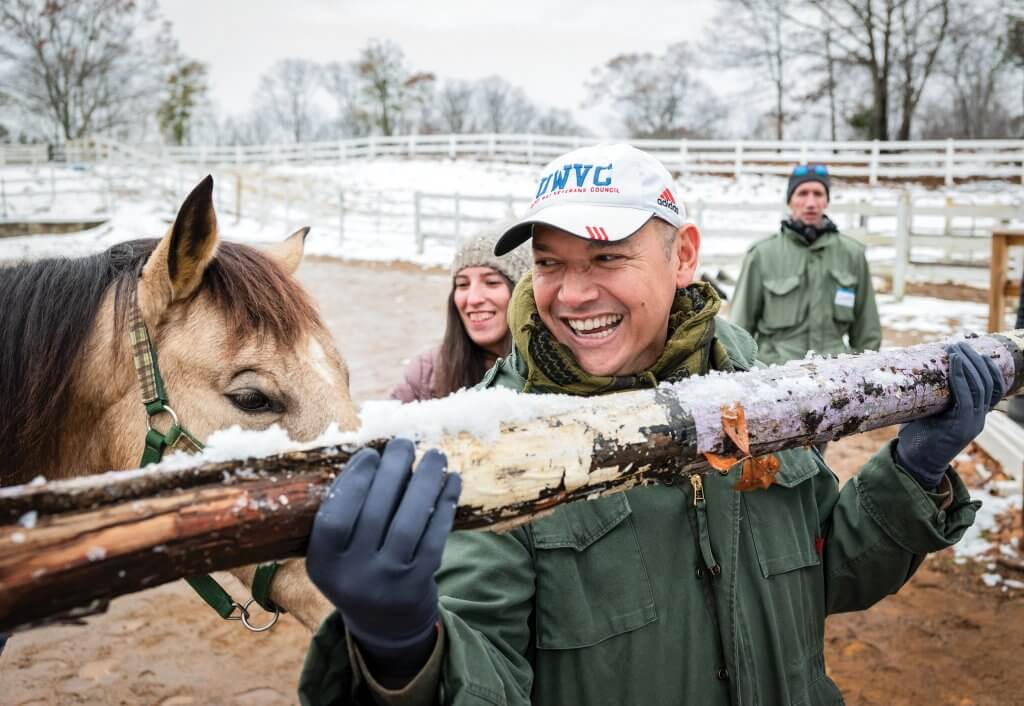
“When you’re around horses you realize right away that they are very present. It’s not like being with a dog. Dogs really just want to please you. And they’re predatory by nature. But horses are prey animals, and that means they are consistently reading and sensing their environment,” says Stone, who graduated from Monmouth in 1992 at the age of 29 with a degree in communications. “That’s how they’ve survived for millions of years. And when you’re with a horse they bring you right into the present moment as well. You need to stay present or you’re going to get hurt. And that’s a real gift, because most of us aren’t in the present. We’re thinking about yesterday or worrying about tomorrow.”
To be sure, Stone had plenty to worry about during her formative years, which were both financially strained and emotionally tumultuous. When Stone was just 13, her father—a former Merchant Marine who suffered from PTSD—attempted to take his own life at home one afternoon. In a panic, Stone’s mother called the police, who entered the house and eventually wound up shooting Stone’s father through Stone’s bedroom door, leaving him paralyzed from the waist down.
“I spent the next several years in and out of VA (Veterans Affairs) hospitals trying to get care for my father, who eventually needed to have his legs amputated,” recalls Stone, whose mother died of lung cancer four years after the shooting. “I spent a lot of time with the men at those hospitals, and it was just a god-awful site. Men suffering or dying on gurneys. Rats in the hallways. Just wretched. I would sometimes play piano for them and sing songs, and I promised myself that one day I would do something to help them.”
Stone also vowed to buy her own horse once she’d graduated from college, a dream that was financially out of the question during her youth. And so, shortly after graduating from Monmouth, she leased her first “crazy thoroughbred” and then bought her own horse in 1997, a roan thoroughbred named Tristan who is currently 30 years old.
“I think the real reason I always wanted my own horse is that I just love the experience,” she says. “There’s something very spiritual about the connection you have with them. There’s no other feeling like it in the world.”
And this, says Stone, is what makes these animals so ideally therapeutic for victims of trauma. Not only are they mystifyingly captivating, but they also reflect one’s internal state of mind at all times.
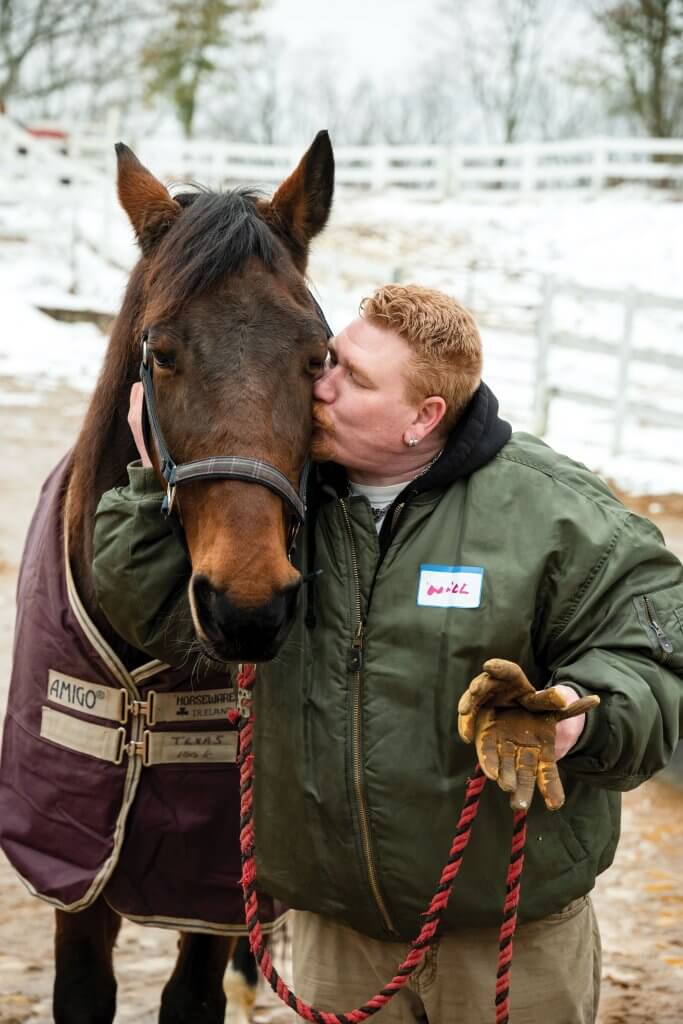
“They can hear your heart beat from four feet away. They can sense a tiger from a quarter mile away and they can tell whether or not that tiger is hungry,” says Stone. “So if you’re afraid or timid or at peace, the horse will mirror and reflect that emotion. That’s how they’ve survived. They’re always reacting.”
Before Stone could merge her passion for horses with her internal promise to help U.S. vets, she first had to endure even more personal tragedy of her own. In 1997, her horse kicked her in the head, fracturing her skull and causing a traumatic brain injury from which she took more than a year to fully recover. Shortly thereafter, Stone was involved in a car accident that resulted in the death of a young boy—and that, she says, was when she first began to realize that she too was suffering from PTSD.
“And the only place I could go to feel any degree of peace was at the barn with Tristan,” says Stone. “That’s when I first made the connection. Tristan saved my life. And he was a very good therapist.”
Equine therapy was barely in its infancy at the time, but in 2012 Stone purchased 25 acres of land in Virginia, where she figured she would start her own program 10 or 15 years down the road, assuming she’d wait until she retired from the mortgage business. But fate, she says, had other plans.
Three years after purchasing the Virginia property, Stone learned that a 15-acre farm two miles from her house was up for lease, so she decided to take a look. The evening after she visited the property, Stone says she woke up in the middle of the night with an unshakable conviction that she should begin her equine therapy journey much sooner than expected. So she leased the land in early 2015, got her necessary certifications, and by the spring of that year Serenity Stables began treating its first veterans—and it has served more than 1,000 individuals since.
“When I sit back and think about it, I’m struck by how we should all listen to the voice inside of us that pushes us toward our destinations,” says Stone. “This project was the first time I actually did that. And it’s been amazing.”
***
It’s important to understand that equine-assisted therapy is not about riding horses or conversing with a human therapist in the traditional sense. Instead it’s about allowing veterans to interact with the horses in myriad ways, giving them time to react on those interactions, and then using those reactions to open pathways to healing.
“Talk therapy is when I ask a question and the client responds in order to process their feelings. But with equine therapy, it’s about a relationship between the client and the horse, which I help facilitate,” says Brooke Lichter ’14, ’16M, a licensed social worker who earned her bachelor’s and master’s degrees in social work from Monmouth. Lichter—who is certified through the Professional Association of Therapeutic Horsemanship International as an equine specialist in mental health and learning—was instrumental in helping Stone create Serenity Stables and now serves as the program’s mental health specialist.
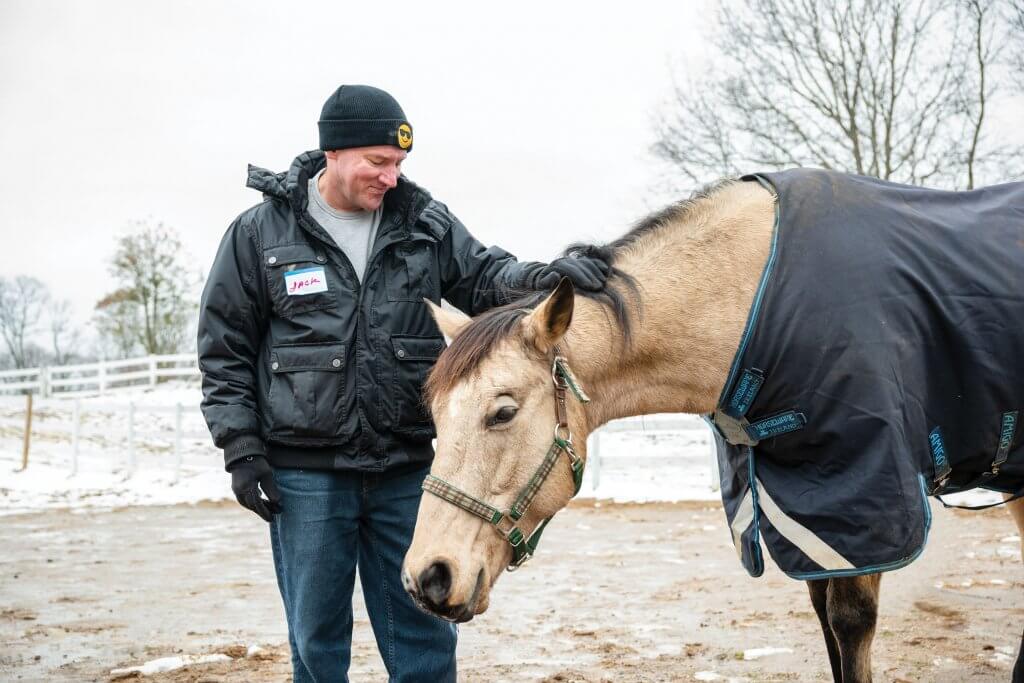
“It’s really the horses who are the therapists,” says Lichter, adding that she and Stone follow therapeutic guidelines established by the Equine Assisted Growth and Learning Association (Eagala) through which they are both certified. “The client will tell me their goals and I, as the mental health professional, try to facilitate exercises that will help. It’s my job to help them work things out with the horse and then come to their own conclusions. I don’t give solutions or advice, because it’s all about learning from the horse.”
According to Stone, the Eagala model asks therapists to watch for four different signifiers: shifts, patterns, uniqueness, or discrepancies.
“Let’s say I send a veteran to go introduce himself to the herd. As he approaches, I notice all the horses stop and don’t move. Then suddenly one of the horses walks around in a circle. That’s a shift and a pattern,” says Stone. “Then the circling horse paws on the ground over and over again. That’s another pattern. So I might pull the client back and say, ‘Hey, notice how that horse is pawing the ground?’ And he’ll say, ‘I was digging for a bomb. And it exploded.’ Now he’s crying for the first time in 10 years, and only then can he begin to process what he’s feeling.”
Currently, most visits take place on Wednesdays, when a group of vets begins with lunch at a nearby restaurant hosted by Mark Otto, executive director of the United War Veterans Council. After lunch the vets come to the farm, where they’re encouraged to walk around and meet the horses. Stone and Lichter ask them which horse they feel connected to, and the women will instruct them on how to groom the animal of their choice. After that Stone either teaches them how to lead a horse or she might let the horses loose in the field to let clients simply observe the animals’ behavior. The session then becomes slightly more concentrated when Stone and Lichter ask the vets to each build an obstacle course using myriad objects—cones, jugs, buckets, wood—each one representing something they’re struggling with, something they’re currently bothered by, or something they may even be happy about.
“Then we ask them to try and lead a horse through the obstacles and tell the horse anything they want to get off their chest, because horses are very good listeners,” says Stone. “So let’s say they build a structure that represents fear or apprehension and the horse stops and won’t go through it. I might then ask them to write down a word that represents what’s bothering them. But we never ask the vets how they’re feeling. That’s not what they want to talk about, because they don’t know how they’re feeling. It’s always related back to the horse, so we only ask questions surrounding the horse and its behavior. The horses become the metaphor for what is going on with them subconsciously.”
Time and time again, Stone says she is surprised by the extremely nuanced and insightful reactions these vets bring to the process. For instance, Stone was working with a group last summer and she was bothered by how much grass had grown in the horses’ ring. It was irritating, she says, because the horses just wanted to eat the grass, making it extremely difficult for the men to lead the animals through their obstacle courses.
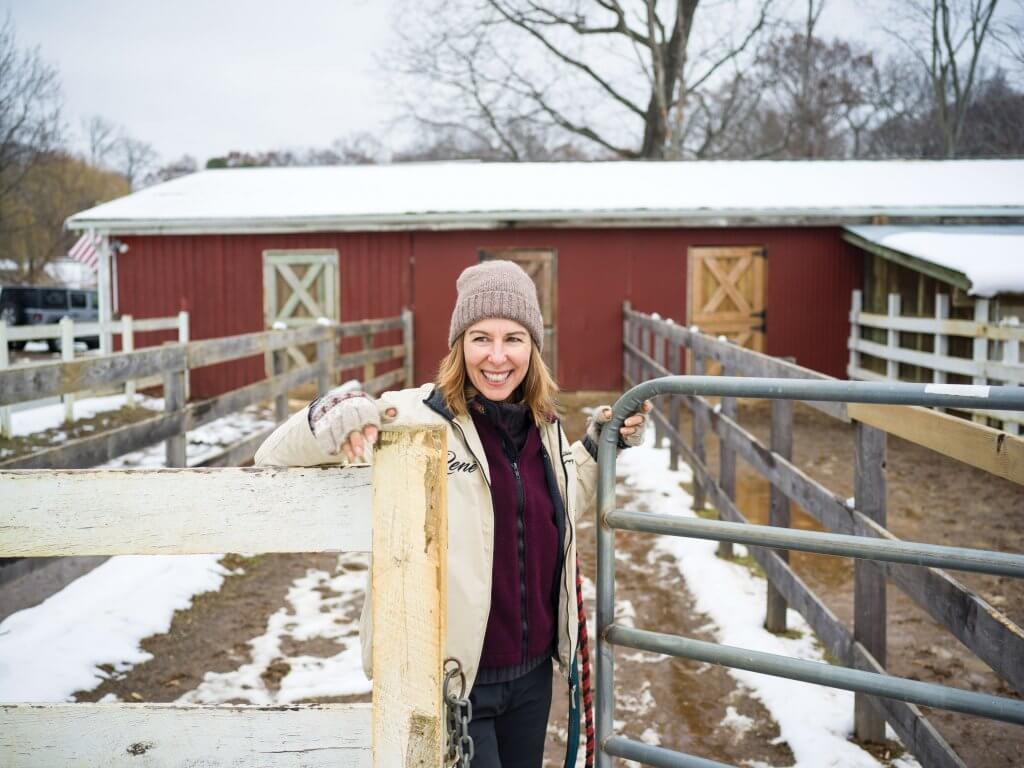
“When we finished the session I asked one of the guys, ‘What did you think?’ And he said, ‘Ya know, I looked at all the grass, and I realized the grass is like our addictions. The horses needed to focus, but all they wanted was grass all the time.’ That just blew me away,” says Stone. “That had nothing to do with me. It’s all about the horses. The horses will always show you what you need to see.”
On a typical week Stone says she sees between five and 10 veterans at Serenity Stables, the vast majority of whom are post-9/11 combat soldiers in their 30s who served in Iraq and Afghanistan. And even though Stone has established long-term relationships with various VA hospitals in the region, one of the most significant challenges is actually getting veterans to come out to the farm in the first place.
“When they get back from active duty these vets are injured and in mental collapse,” says Stone. “They’ve experienced consistent trauma, and then they return home and they’ve lost their unit. Their herd. They were injured in their herd, and they need to be healed in a herd. And that’s part of what we provide, so long as they’re willing to participate.”
To be sure, Stone’s experience with Serenity Stables has not only changed the lives of hundreds of U.S. vets, but it’s also changed her in ways she couldn’t have imagined before she started this program nearly five years ago. “This whole experience has really humbled me greatly, and it’s made me a much more patient and calmer person. If you just quiet your mind and body, you can probably recover from anything. I didn’t used to think that way,” says Stone. “And I see it all the time with these men. I remember one time a vet said to me, ‘Every time I come here, something bad falls off me.’ That right there is more of an accomplishment than any of the mortgage accounts I’ve closed or awards that I’ve won. I will never forget it as long as I live.”